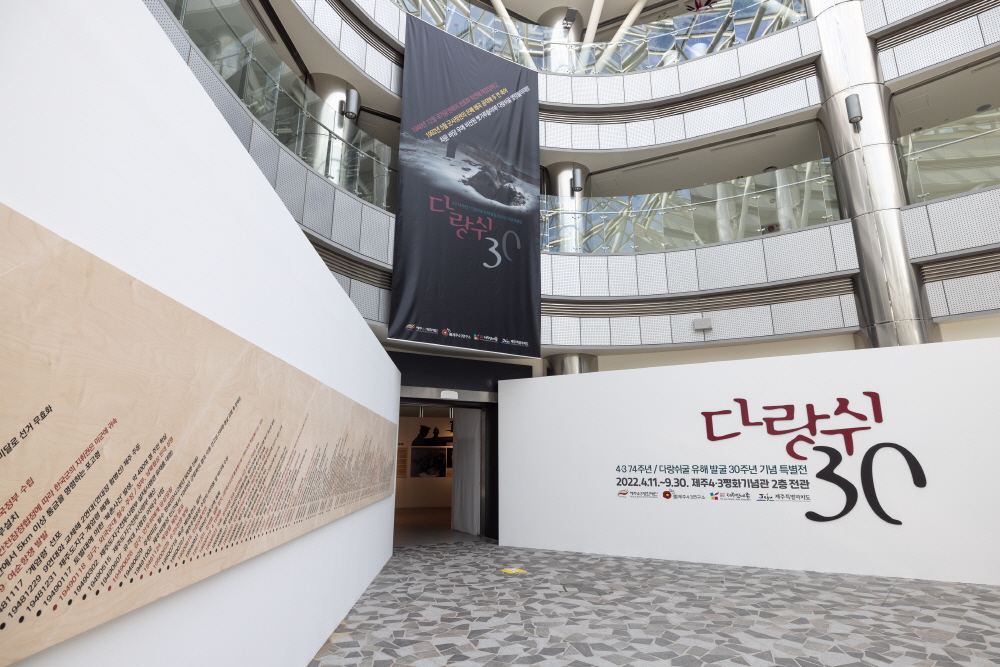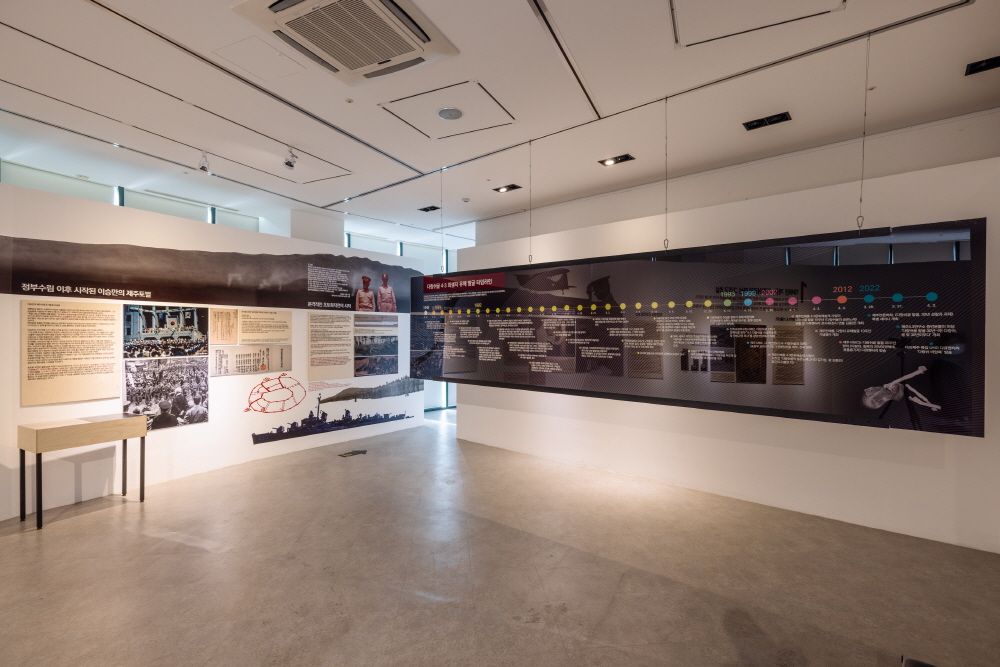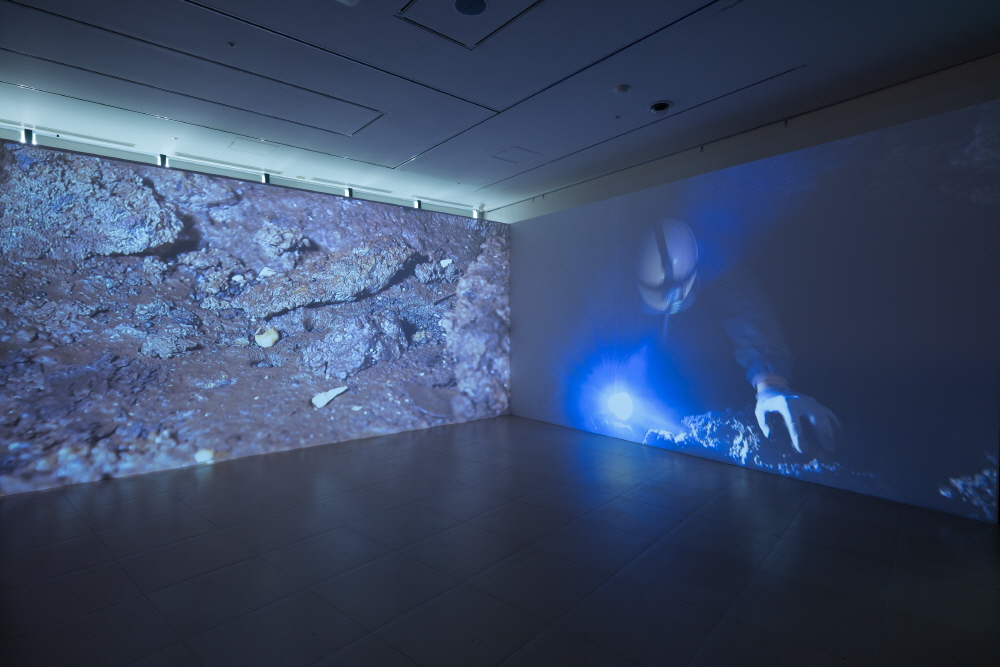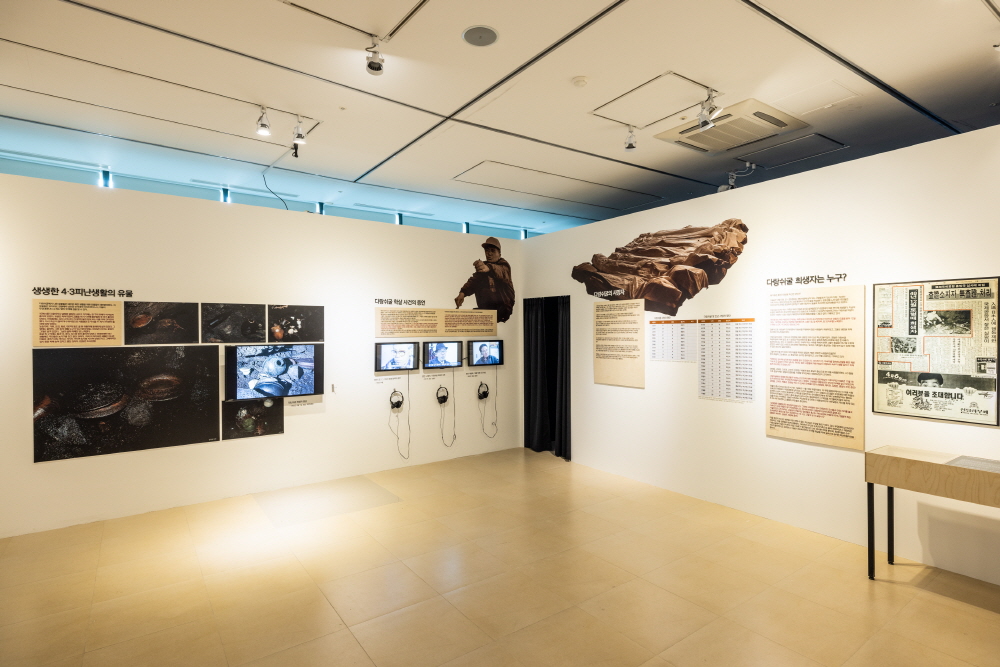Time to shed light on Darangshigul Cave: The Crevasse of History of the Truth-Finding Movement of Jeju 4·3
Special Project
Time to shed light on Darangshigul Cave: The Crevasse of History of the Truth-Finding Movement of Jeju 4·3
Park Kyoung-hun
Executive Director of Darangshi 30 Exhibition

[Second Floor Exhibition Hall Lobby at Jeju 4·3 Peace Memorial Hall]

[Entrance of the Exhibition, <Darangshi 30> Second Floor of Jeju 4·3 Peace Memorial Hall]
A crematorium in Jeju City on May 15, 1992. In front of the altar with only eleven paper cups to offer liquor to the deceased, the bereaved family burst into tears as they expressed their frustration. At that time, Ko Juang-chi, a bereaved family member of Go Gwang-eon, who came from Incheon, stated, “I strongly protested that if there was no other alternative than cremation, I would take even 1/11 of the ashes and have a separate burial. But in the end, I had no choice but to accept the decision.” The bereaved family member felt anguished that the ashes were thrown into the sea.
The remains of the victims who died from the brutal suppression of Jeju 4·3 had turned into dry bones lying in cold Darangshigul Cave for 44 years. Leaving the long, agonizing years of waiting and cruelty, they were compelled to be turned into a handful of ashes and scattered into the sea, pushed through the hasty process of the administrative authorities. It is unimaginable today, but it happened. In the name of the authorities and in the name of the administration, placation and manipulation were attempted at that time. In the end, the administrative act, driving a nail into the hearts of the bereaved families, was executed. 30 years have passed without a thorough investigation into or evaluation of the development of the process that was carried out at that time.
Now is the time to reflect critically if in some way the events surrounding Darangshigul Cave, consumed and discarded in the history of the truth-finding movement of Jeju 4·3, have been regarded only as a driving force of the movement that was stagnated by the public security policy. In the meantime, the government published The Jeju 4·3 Incident Investigation Report, and the Jeju 4·3 Incident Follow-Up Investigations Report 1 was published in 2019 as well. Nonetheless, despite the importance of the excavation of the remains of Darangshigul Cave as a symbolic event in the history of the truth-finding movement, a separate investigation has not been conducted.
The excavation of the remains at Darangshigul Cave itself was a historic event. However, the entire process of excavation and the handling procedure of the remains was ‘another example of living 4·3’. The measures taken by the authorities, who tried to quickly cover the issue through concealment and distortion under the public security policy, demonstrated the perspectives of the political leaders who viewed Jeju society as the ‘Red Island’, a view which prevailed even 40 years after the end of Jeju 4·3. Also, it was an incident that revealed the aspect of Jeju society which intended to exploit by triggering the trauma of the perpetrators and victims which had been dormant for 40 years due to manipulation. 30 years have passed since the entrance of the cave was sealed. Just like the site, this incident is sealed, unable to reveal the truth of that day. Most of the bereaved family members who were alive at the time have now passed, and only a few working-level officials of those days are left. Yet, the truths of the excavation of Darangshigul Cave and its truth are still buried.
What is even more unfortunate is that as compared to ‘Special Room: Replica of Darangshigul Cave’, on public display in the permanent exhibition hall of the Jeju 4·3 Peace Memorial Hall, the actual site was left without further public action having been taken for the past 30 years, while the rights to the property of Darangshigul Cave in Pyeongdae-ri, Gujwa-eup, have not been secured.

[April 1, 1992 A ‘joint investigation team’ composed of relevant experts and journalists is holding a ritual before entering Darangshigul Cave]

[Video of the inside of Darangshigul Cave played in a separate room]

[Section 2 of “Darangshi 30” (top)]
There are still unrecovered remains of the victims from the excavation that were rushed through for cremation in 1992 and scattered historic items left at the site, just as they were from the time of Jeju 4·3 in 1949. However, the reality is that formal excavation has not been conducted yet. Recently, the 4·3 Peace Foundation has administered a state-funded remains excavation project, but the site was outside the scope of the project.
In 2022, marking the 30th anniversary of the excavation of Darangshigul Cave, it is necessary to reflect again on the excavation. The discovery of the remains in 1992 stands at the heart of the chronology of the truth-finding movement. In addition, it was a hasty and crippled process due to the interference with the excavation by the police and administrative authorities of Jeju, who were under the umbrella of the central government when national security was considered as a priority. The decision that was made against the wishes of Jeju residents and bereaved families was reached. It is necessary to thoroughly examine this incident and to properly establish a page in the history of the truth-finding movement by highlighting the dark history of Jeju society of those days again.
This exhibition serves to draw an outline of the truth of Darangshigul Cave although the full picture has not been revealed yet. In addition, it was designed to raise social interest in the excavation that was concealed, just like crevasses in a glacier, since it was pushed to the margins of the truth-finding movement history and 30 years have passed.
However, this exhibition was organized with many limitations. The exhibition is only the primer for uncovering the historical truth of the incident on its full scale. It can only serve in that role since the exhibition was planned prior to a full-scale excavation and before an in-depth investigation of those involved was conducted, or at least before an official report has been published.
Nevertheless, I think this exhibition is meaningful in its own way. It provides an opportunity to re-evaluate the circumstances of the incident that was described as follows; “What is considered as nonsense nowadays happened in those days. In the name of the authorities and in the name of the administration, placation and manipulation were attempted.” Also, although the incident bears great historical significance, land purchase has not yet been attempted; however, there is progress in recent land purchase efforts. And, it has contributed to calling for social responsibility regarding the excavation.
Compensation and reparation for 4·3 is being discussed and its execution is getting closer. Finally, we are aware that we have reached an era where we have to attend to each and every issue we have missed in the past. It is <Darangshi 30> that exhibits the effort to tackle one of these built-up issues.